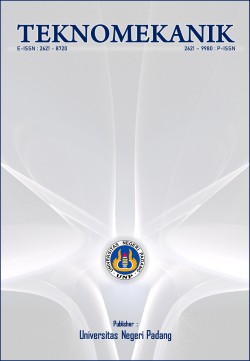Implementation of video learning to lmprove student learning outcomes at SMK N 2 Padang
DOI:
https://doi.org/10.24036/jptk.v5i1.25923Keywords:
Learning Videos, Youtube, Learning OutcomesAbstract
During the COVID-19 pandemic, the learning process, which was usually carried out face-to-face in front of the class, could no longer be carried out. So that with the spread of the covid-19 virus, the teaching and learning process has turned into distance learning to limit the spread of the covid 19 virus. Online distance learning began in early March 2020. This requires educators to think about what methods and media will be used. used for the teaching and learning process. For this reason, learning videos (Youtube) are used in the classroom teaching process. The purpose of this study was to improve learning outcomes by applying learning videos (Youtube) in Class XII BDP 1 SMK N 2 Padang. Based on the data analysis of the first cycle to the second cycle there is an increase in learning outcomes. The percentage in the first cycle of 72.73% rose to 91.34% in the second cycle. The increase of 18.61% in the percentage result in both cycle I and cycle II has reached the percentage that the author set at the beginning of the study, which is 65%. The average student learning outcome in the first cycle was 82.57 with a percentage of 72.73%. At the end of the second cycle learning outcomes increased to 87.45 with a percentage of 91.34%. The minimum completeness standard in this study is 80 and the research indicator is determined that 80% of students complete above the SKM. In this study, there were 91.34% of students above the SKM. Based on the results of this study, it is suggested that teachers in the field of online business and marketing skills competency studies can use learning videos for online learning.
Downloads
References
Arsyad, A. (2002). Media Pembelajaran. Jakarta: Raja Grafindo Persada.
Dabbagh,N.and.Ritland.B.B (2005).Online Learning, Concepts, Strategies And Application. Ohio:Pearson.https://www.haidunia.com/pengertian-pembelajaran-online-menurut-ahli/
Dimiyati dan Mujiono. 1999. Belajar dan Pembelajaran. Jakarta: Rineka Cipta.
Hamalik Oemar. (2006). Proses Belajar Mengajar. Jakarta: Bumi Aksara.
Mustofa,dkk,(2019:153)http://eprints.umm.ac.id/72017/3/BAB%20II.pdf,pengertian pembelajaran daring.
Ronald,H.Anderson.(1994).Pemilihan dan Pengembangan media Video Pembelajaran.Jakarta:Grafindo Pers.
Slameto. 2003. Belajar dan Faktor-Faktor Yang Mempengaruhi. Jakarta: Rineka Cipta.
Suharsimi Arikunto, dkk Editor.1989. ProsedurKependidikan Jakarta:Bina Aksara. (2006:3). Penelitian Tindakan Kelas. Jakarta: Bina Aksara.
Surat Edaran Mentri Pendidikan dan Kebudayaan Nomor 4 tahun 2020 tentang Pelaksanaan kebijakan pendidikan dalam masa darurat penyebaran corona virus Disease (Covid-19).
Suwarsih Madya. 2006. Teori dan Praktik Penelitian Tindakan (Action Research). Bandung: Alfabeta.
Downloads
Published
Issue
Section
License
Copyright (c) 2022 Maha Putri Handayani Maha Diar

This work is licensed under a Creative Commons Attribution 4.0 International License.





